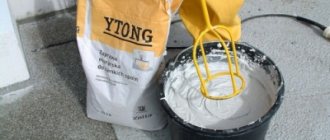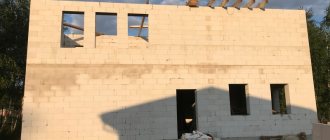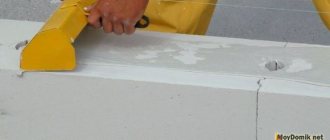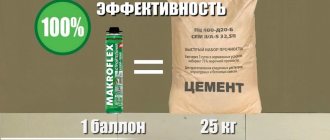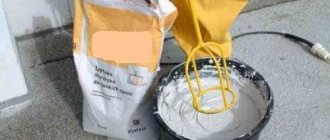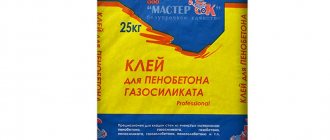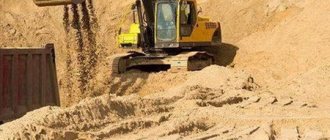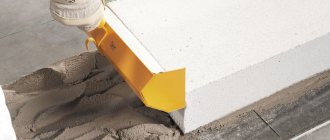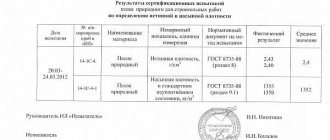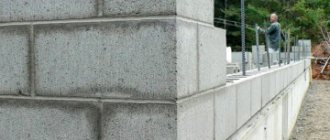Houses built from aerated concrete are characterized by reliability and durability. The strength and other operational parameters of the building largely depend not only on the quality of the blocks, but also on what kind of glue and in what quantity was used for the masonry. The choice of mixtures for joining aerated concrete products today is huge, but a good product is not cheap.
Agree, it is better to know in advance how much glue will be needed for the construction of an aerated concrete building. Then you will not have problems due to the fact that you purchased more or less mixture than you need. Determining the glue consumption for aerated concrete blocks per 1m3 is actually not difficult. You need to know some features and nuances.
In this article we will tell you why it is so important to be able to calculate the optimal amount of glue; we will provide a formula by which you can easily understand how many bags of the mixture you need. We will also list and consider the factors on which the amount of adhesive consumption depends. We will give advice on choosing and preparing glue for laying gas blocks.
Why do you need to know glue consumption?
In construction, houses made of aerated concrete are more economical than brick buildings. This is due not only to the cheapness of the blocks, but also to the fact that special glue is used as a connecting element.
It costs 1.5-2 times more than cement-concrete mortar, which is used for bricklaying. But at the same time, its consumption is six times lower. The result is good savings. But, unfortunately, not everyone knows how to determine how much adhesive composition will be used for masonry. This leads to a number of problems.
Adhesive for laying aerated concrete blocks does not shrink significantly, and also eliminates the appearance of places with increased heat conductivity, providing a stronger and more durable connection
The advantages of having the knowledge and skills to accurately calculate the required amount of glue for building a house from aerated blocks are obvious.
Firstly, this is an opportunity to save money. If you correctly determine the amount of consumption, then there should be no extra bags of glue left after the completion of construction work. Accordingly, there will be no overpayment.
Secondly, situations where the glue has run out and you need to buy more are excluded. The store where you previously purchased the mixture may not have the brand you need. Then you will have to either choose glue from another company, which is not welcomed by experts, or look for the required product elsewhere, or wait for delivery of the required brand. In the latter case, construction will have to be suspended for some time. If you calculate the glue correctly in advance, then such hassle can be avoided.
Thirdly, you will be able to check the estimate compiled by specialists. Some construction companies are unscrupulous and deliberately inflate costs.
Fourthly, knowing the specifics of the calculation, it will be possible to dilute the amount of dry adhesive that is currently needed to lay a certain number of aerated concrete blocks.
Glue for gas blocks is prepared by combining dry matter with water. The mixture is not stored for a long time: it should be used within 2.5-3 hours
If during the construction of a building made of aerated concrete, significantly more or less glue was used than the planned volume, this indicates that either the calculation of the mixture was carried out incorrectly, or significant errors were made during the construction of the structure, for example, the wrong installation technology was used.
How much cement is needed per cube of mortar? How much cement or glue is needed to lay a cube of blocks?
Of course, when starting to build a house, you would like to at least approximately estimate the cost of construction.
Or at least some of its stages. Today we will tell you how to calculate the cost of the materials needed to build walls from gas silicate blocks. We have already talked about how, based on the plan of your house, you can calculate how many blocks are needed per house. Now let’s try to at least roughly calculate how much cement or glue is needed for laying the blocks. When laying walls made of gas silicate blocks, you can use an adhesive mortar or a regular cement-sand mortar. When choosing a solution, you should know the pros and cons that both materials have. Due to the poor geometry (significant difference in size between individual blocks - more than 3 mm) of the blocks we purchased, we could not use the adhesive solution. In addition, using an adhesive solution for masonry requires certain skills.
Having weighed all the pros and cons, and chosen the type of solution, you can begin to calculate the volumes of necessary materials.
Payment procedure
Aerated concrete blocks have precise geometry. Due to this, they can be laid on a thin layer of the binder mixture. When determining glue consumption, you need to adhere to a special algorithm.
Calculation procedure:
- Calculate how many aerated concrete blocks are needed to construct a building.
- Assess the evenness of the surface of the products and prepare them for laying.
- Decide on the thickness of the seam.
- Read the instructions for the glue. Pay attention to dilution and consumption. Similar information is provided on the back of the bag.
- Calculate the required amount of adhesive dry substance.
The standard consumption of aerated concrete adhesive per 1 m3 varies from 15 to 30 kg of dry mass. With a layer thickness of 1 mm, about 25 kg of mixture per cubic meter is required. This is one bag of composition.
Similar proportions are typical for blocks with a flat surface, without visible deformations. It is recommended to take one bag of glue in reserve. For example, if 20 cubic meters of aerated concrete blocks were purchased, then 21 bags of adhesive will be required to lay them.
The seams between aerated concrete blocks are made from 1 mm. An adhesive layer of 2-3 mm is considered optimal. For comparison, the thickness of the cement-concrete mortar for reliable fixation of bricks according to the standards must be at least 10 mm
It is not always possible to purchase a batch of ideal blocks. Therefore, in practice, glue consumption can be 1.5 bags per 1 m3. All these figures are approximate and depend on various factors.
To accurately calculate glue consumption, you should use the following formula: ((L+H)/(L×H))×d×1.4
P is the glue consumption in kilograms per cubic meter;
L, H – length and height of the aerated concrete block, respectively (in meters);
d – seam thickness;
1.4 – the consumption value of the dry adhesive mixture, provided that the layer thickness is 1 mm.
Today there are many specialized resources where you can determine glue consumption using an online calculator. This tool takes into account various factors that can affect the volume of block bonding compound.
But for maximum accuracy, it is better to perform all calculations manually. In this case, it is necessary to take into account the dimensions of door and window openings, and the gables of the building. It is important to be as careful as possible when filling out the form. When carrying out calculations, you need to carefully operate with units of measurement, otherwise there is a risk of seriously making mistakes in the calculations.
How much cement is needed to lay a cube of blocks?
Now it remains to calculate the cost of masonry mortar (the cost of cement for masonry mortar) for the entire volume of masonry for the house. To do this, you need to figure out: how much mortar is needed to lay one cube of blocks?
For laying a cube of blocks, an average of 0.15 - 0.20 cubic meters of masonry cement-sand mortar 1:4 or 350 kg of cement x 0.15 (0.2) = 52 (70) kg is used. cement for laying cube blocks. Plus sand.
Now all that remains is to multiply 1). volume of blocks in cubes for laying the walls of your house by 2). the volume of cement is 52 (70) kg for laying a cube of blocks and 3) the cost of 1 kg of cement (or first divide by 50 and multiply by the cost of a bag of cement). And don't forget about the sand!
Features of calculating glue consumption
The amount of glue required to hold aerated concrete blocks together is calculated in kilograms per square or cubic meter.
When purchasing bags of glue for laying aerated concrete blocks, it is important to pay attention to the shelf life of the product. If the composition is expired, then its bonding properties will be worse
To achieve the desired result and obtain a high-quality, reliable seam, you need to observe all proportions when diluting dry matter and follow the recommendations of specialists. You should not try to save money by adding more water to the adhesive mixture than indicated in the instructions. This reduces adhesion.
It is also not recommended to make the seam thinner than necessary to minimize consumption - this will worsen the quality of the bonding of the blocks.
When determining the amount of glue consumption, you need to take into account some features. The consumption declared by the manufacturer may be lower or higher than the actual one. This is explained by the influence of a number of additional factors on the result.
What determines glue consumption?
With large volumes of work, it is quite difficult to determine how much glue is needed for laying aerated concrete blocks. It happens that not 25 kg of glue is used per cubic meter, as planned, but 30-40 kg or 14-15 kg.
To obtain consumption data that is as close to real as possible, it is worth taking into account the influence of a number of factors.
You should not use used blocks. Their price is much lower than new products. But they have significant defects. To make smooth masonry and build a strong house, you will need a lot of glue
The amount of adhesive required for laying aerated concrete blocks depends on the quality of the product. The cheaper the mixture, the worse its composition. It may contain too much sand and other unnecessary fillers.
This negatively affects the bonding properties. Accordingly, the consumption of such glue will be high. If the bulk is represented by a binder, then the mixture will be used more economically.
The geometry of the blocks also has a great influence. The smoother the surface of aerated concrete products, the thinner the layer of masonry adhesive can be made. This will allow you to achieve maximum savings. The presence of defects, on the contrary, requires the use of more adhesive to eliminate them.
The masonry technique and the level of skill of the builder play a certain role. Inexperienced workers often make mistakes and use too much compound to correct them. This does not improve the quality of the result, but the glue consumption increases.
The consumption of the mixture largely depends on the thickness of the seam the craftsman will make. The higher this indicator, the more glue will be spent on building a house.
Another factor is the presence of a reinforcing layer. Often, when creating aerated concrete walls for two-story and taller houses, builders use reinforcement. Then a thicker layer of glue has to be applied to the blocks. This increases material consumption.
It is not worth building an aerated concrete house in the rain. Water will get onto the blocks and into the glue container. This will reduce the quality of construction
Also, the consumption of the composition largely depends on the temperature and weather conditions. The hotter it is outside or in the room where the wall is being built, the more glue will be consumed. This is explained by the fact that the evaporation of the mixture increases.
Approximate glue consumption in different cases
It is important to take into account all the nuances when calculating the amount of glue consumption for laying aerated concrete blocks. This will allow you to determine as accurately as possible how many kilograms of dry mixture will need to be purchased to build a house.
The table below shows the glue consumption depending on the thickness of the seam and the brand of the composition.
| Brand of adhesive mixture | Seam thickness, mm | Consumption of adhesive mixture in kg per 1 m3 |
| AEROC | 1 | 20 |
| Ceresit ST 21 | 2 | 52 |
| Ytong | 2 | 60 |
| UDK | 1 | 25 |
| Kreisel 125 | 2 | 50 |
| Baumit PorenbetonKleber | 2 | 60 |
The approximate consumption of glue depending on the thickness and density of aerated concrete blocks is given in the following table.
| Block thickness in cm | Density of aerated concrete blocks in kg/cub.m | Glue consumption in kg per cubic meter |
| 10 | 300-400 | 19,3-19,4 |
| 15 | 300-400 | 19,9-21,0 |
| 20 | 300-400 | 16,4-16,8 |
| 25 | 300-400 | 15,9-16,2 |
| 30 | 300-400 | 15,5-15,8 |
| 37,5 | 300-400 | 15,1-15,4 |
| 40 | 300-400 | 14,9-15,1 |
These consumption indicators are relevant for cases where the thickness of the adhesive layer does not exceed 1-2 mm, and the blocks do not have significant defects in terms of geometry.
How much cement is needed per cube of mortar? How much cement or glue is needed to lay a cube of blocks? :
Hi all! I wanted to praise your site. I really liked it here.
Thank you! Nice to read such useful information!
We are very glad if we could help you!
Hello. you write: “For laying a cube of blocks, an average of 0.15 - 0.20 cubic meters of masonry cement-sand mortar 1:3 or 350 kg of cement x 0.15 (0.2) = 52 (70) kg is used. cement for laying cube blocks. Plus sand.”, and in Option 1 of the calculation: “350 kg of cement is required for a cube of 1:4 masonry mortar;” That is, it turns out that for 1 m3 of blocks and using a 1:3 cement-sand mortar, it is necessary to take not 350 kg of cement but 466 kg.
Z.Y. or am I wrong?
Sergey, good afternoon! Of course, you are right. Thank you for noticing the typo. Already fixed. Thanks again. It's good to have thoughtful readers!
This is a site for all sites! Thanks a lot.
Secrets of economical spending
If you follow some expert advice, the use of adhesive when laying aerated concrete will be more economical.
Experienced master builders know how to work with aerated concrete and glue. Therefore, they build a house faster and more economically in terms of material consumption. When constructing a building from aerated blocks on your own, you need to be careful and think through everything carefully, do not rush
The use of special tools speeds up the construction process and minimizes the use of glue, and, accordingly, reduces the cost of work. It is recommended to use a ladle, a rubber hammer, a square, a grater with sandpaper, and a saw for masonry.
The glue should be applied with a spatula or a special spatula. Then the composition will apply more evenly and it will be possible to minimize its consumption. Before laying, the blocks must be cleaned of dirt. It is important to dry them well so that they are not wet.
How much cement is needed per cube of mortar? How much cement or glue is needed to lay a cube of blocks?
Of course, when starting to build a house, you would like to at least approximately estimate the cost of construction.
Or at least some of its stages. Today we will tell you how to calculate the cost of the materials needed to build walls from gas silicate blocks. We have already talked about how, based on the plan of your house, you can calculate how many blocks are needed per house. Now let’s try to at least roughly calculate how much cement or glue is needed for laying the blocks.
When laying walls made of gas silicate blocks, you can use an adhesive mortar or a regular cement-sand mortar. When choosing a solution, you should know the pros and cons that both materials have. Due to the poor geometry (significant difference in size between individual blocks - more than 3 mm) of the blocks we purchased, we could not use the adhesive solution. In addition, using an adhesive solution for masonry requires certain skills.
Having weighed all the pros and cons, and chosen the type of solution, you can begin to calculate the volumes of necessary materials.
Tips for choosing adhesive mixtures
The range of adhesives for aerated concrete masonry on the market is quite extensive. All compositions are divided into gray and white. The first ones are considered universal. They can be used at any time of the year. They contain additives that increase frost resistance. This glue has certain temperature limits for use.
White compounds are suitable for work in the warm season. They contain Portland cement. This substance gives the mixture a light tint. White glue should be used for laying blocks indoors. The seam is aesthetically pleasing and does not require additional processing.
Typically, a gray type of glue is used to build aerated concrete houses. This is explained by the fact that this composition is universal and is more often found on sale.
Adhesives for aerated blocks from the following companies are very popular: Ceresit, Kreisel, UDK, Ytong, Real. Products from new companies appear on sale regularly. Therefore, not all builders can comment on the quality of a particular brand of glue. A little-known mixture for laying gas blocks can be no worse in quality than branded products.
Due to the wide range of adhesive compositions for aerated concrete blocks, many have problems with choice. The question of which glue is best for building a house is quite relevant. There are different ways to figure out which mixture to use.
Experts advise paying attention to the composition. It should contain a lot of binders and a minimum concentration of additional inclusions, which are used to reduce the cost of products. The choice is made through testing and comparison.
Builders recommend purchasing 2-3 types of glue in quantities of up to 1 kg and testing their quality in practice. The solution should be prepared according to the manufacturer's instructions. Next, glue two blocks together with each mixture. Leave to harden for a day. A day later, try to break the structure in the seam area.
You should purchase glue for laying gas blocks from reliable companies. It is better to choose well-known and proven brands. This guarantees high quality mixture
The result will show how good the glue was used. If the fracture site coincides with the seam, then it is better not to use this mixture. If only the aerated concrete block was damaged, this indicates the high quality of the glue. This composition can be safely used for any type of work.
If the fault partially touches the seam, this means that the adhesive mixture will not provide sufficient strength to the structure, so it is better not to use it, especially when constructing multi-story buildings.
Another way to determine the quality and choice of glue is to check its weight after hardening. It is necessary to buy several types of adhesive compositions for testing and pour them in equal quantities into containers of the same size.
Wait a day and evaluate the result. To do this, you need to weigh each of the containers. Preference should be given to the glue whose weight decreased the most after hardening. This indicates that a lot of moisture has been removed and the composition has become more durable.
If you bought glue of an unknown brand, then it is better not to start building a house using it until the quality is checked. It will be more difficult to correct the situation later
Testing glue using the above methods is troublesome, costly in time, effort and money. But such a check will help to accurately assess the quality of the composition. After all, manufacturers' promises do not always correspond to reality.
It makes sense to carry out testing when planning large-scale construction. This will help not only check the quality of the glue, but also more accurately calculate its consumption.
How much cement is needed to lay a cube of blocks?
Now it remains to calculate the cost of masonry mortar (the cost of cement for masonry mortar) for the entire volume of masonry for the house. To do this, you need to figure out: how much mortar is needed to lay one cube of blocks?
For laying a cube of blocks, an average of 0.15 - 0.20 cubic meters of masonry cement-sand mortar 1:4 or 350 kg of cement x 0.15 (0.2) = 52 (70) kg is used. cement for laying cube blocks. Plus sand.
Now all that remains is to multiply 1). volume of blocks in cubes for laying the walls of your house by 2). the volume of cement is 52 (70) kg for laying a cube of blocks and 3) the cost of 1 kg of cement (or first divide by 50 and multiply by the cost of a bag of cement). And don't forget about the sand!
Now you have all the information to make a decision: which mortar to use for laying the blocks: adhesive or cement-sand.
Subscribe to the FREE BONUS “Eight practical techniques that must be used when laying walls from blocks”, laying walls from gas silicate blocks, provided you follow certain rules and know the secrets of masonry, will not present any difficulties for you.
See you soon on the pages of the blog “How to build a house”!
Description and characteristics of the material
The blocks can be laid on traditional cement mixtures or special dry compositions from which the mortar is prepared. But preference should be given to the latter. Despite the fact that glue is twice as expensive as cement, it is more economical. But this is not the only advantage.
It consists of the following components:
Such compositions are used when laying blocks of aerated concrete, foam concrete and other materials with a high level of moisture absorption. They have high adhesion, moisture and frost resistance and plasticity. The glue sets quickly without shrinkage, eliminating the risk of the formation of “cold bridges” characteristic of cement mortars. But to achieve this effect, you need to make the correct calculation of the aerated concrete adhesive.
Another positive quality is its simplicity and ease of use. To prepare the solution, you need to mix the dry composition with water in the proportions indicated on the package. For mixing, use a drill with a mixer attachment or a construction mixer.
general information
The structure of aerated concrete material is very porous. For this reason, the mortar on which the blocks will be laid must have high astringent properties. Special ready-made mixtures fully satisfy this requirement.
The main materials from which aerated block adhesive is made:
- cement grade 500 and higher;
- fine sand;
- various additives (for moisture resistance, increasing strength, viscosity, etc.).
Compared to cement-sand mortar, the price of ready-made mixtures is much higher. But thanks to the low cost of adhesive bases, the cost is almost equal, and the quality of the masonry increases.
Advantages of ready-made mixtures:
- high plasticity;
- water-repellent properties;
- do not collapse from severe frosts;
- hardens very quickly (no need to wait before laying the next row).
Using glue you can achieve high adhesion of aerated concrete blocks. And also the seams will not crack at high humidity levels.
The types of glue used in construction vary depending on the season. If work takes place in winter, then frost-resistant mixtures must be used. They contain special plasticizers that allow aerated concrete to be laid at low temperatures. This glue is prepared in warm water (not lower than 35 degrees). It should be taken outside immediately before application. You need to consume the finished material as quickly as possible. This should take no more than five minutes.
You can significantly reduce the consumption of glue for gas silicate blocks by 1 m³ if you use a special tool. This will also help reduce laying time. Required tool:
- cement bucket;
- rubber mallet;
- high carbon steel hacksaw;
- mixer (required);
- corner 90 degrees;
- grater or sandpaper;
- metal grater.
The aerated concrete block (sibit) must be dry. Before applying the glue, it should not be wetted, as when using cement-sand mortar. The block also needs to be cleaned of dirt, if any.
Briefly about the main thing
The consumption of mortar for the construction of a brick wall depends on the type and brand of the mixture, geometric evenness, type and size of the brick, and the thickness of the joints.
Calculation of consumption during the construction of a private house is carried out either in cubic meters or kilograms.
Cement, as the main component of masonry mortar, is the main expense item in the construction of walls. Its consumption depends on the brand and the amount applied. For example, when mixing cement and sand in a ratio of 1:3, ¼ cube of the solution is added as a binder. That is 0.25 m³.

